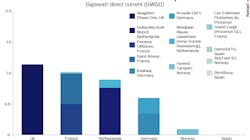Offshore wind sector’s progress falters, Rystad reports
Offshore staff
OSLO, Norway — Offshore wind capacity is expected to grow this year, but only by 2% due to project delays, Rystad Energy reported.
"Wind energy—including onshore and offshore, both of which were previously on a robust growth path—has faced hurdles that could hinder its expansion,” says Vegard Wiik Vollset, vice president and head of EMEA renewables research at Rystad Energy.
The European offshore wind sector has seen a modest 2% annual growth in installations for this year. Offshore wind was on a strong upward trajectory, but a recent spate of delays to key projects has highlighted the vulnerability of the market. In the past two months, several developers and governments have announced delays or potential cancellations of projects in the UK and Denmark. The causes include increasing development costs, difficulty in securing desirable offtake deals and regulatory changes.
As a result, these two nations are now expected to miss their 2030 offshore wind targets by a larger margin than previously anticipated, Rystad reported. For example, the UK is now expected to reach a maximum of 46.8 GW of offshore wind capacity by 2030, missing its governmental target of 50 GW. Similarly, Denmark is now expected to reach slightly over 10 GW, below its target of 12 GW.
Despite the obstacles faced, Rystad says the offshore wind industry perseveres, showcasing its resilience and long-term promise. France has commissioned its inaugural offshore wind facilities, Saint-Brieuc and Fecamp. Furthermore, the world's largest floating offshore wind farm, Equinor's 88-MW Hywind Tampen off the coast of Norway, began operations this year.
Getting offshore wind back on a growth trajectory will require considerable changes to project development and permitting processes, Rystad said, as well as continued investment in R&D to keep costs affordable while maintaining efficiency. Given the sector's strong potential to contribute to decarbonization and economic growth, however, there is a strong incentive to overcome these challenges.
In addition, rising interest rates are putting pressure on the economics of new offshore wind projects. According to Rystad Energy, this is turning many schemes into a financial burden on developers’ balance sheets.
10.26.2023
